Improved 3-D Indoor Positioning Based on Particle Swarm Optimization and the Chan Method
Abstract
:1. Introduction
- (1)
- We proposed a novel 3-D positioning system based on PSO and the improved Chan algorithm to greatly improve the position accuracy while decrease the computation time.
- (2)
- In our system, PSO is used to obtain the initial location of the target, which can effectively eliminate the NLOS error. Based on the initial solution, the Chan algorithm performs iterative computation quickly to obtain the final precise location of the target.
- (3)
- The proposed method will have computational benefits in dealing with the large-scale base station positioning problem while having good practicability and lower complexity.
2. Problem Formulation
3. The Proposed Positioning Model
3.1. System Model
| Algorithm 1. The Improved PSO Positioning Method |
| %% Output: the initial calculated value of the target position %% |
| Begin |
| For Do %% is each particle |
| Initialization of particles |
| End |
| Do |
| For Do |
| If Then ; |
| End If %% is the best position of th particle |
| End For |
| opti %% obtain the optimum solution |
| For Do |
| update particle velocity and position according to Equation (28) (29). |
| If Then ; |
| End If |
| If Then ; |
| End If |
| End For |
| End Do |
| %% is the initial calculated value of the target position |
| End Begin |
3.2. The Improved Chan Algorithm
3.3. The Proposed Positioning Method Using PSO
- (a)
- if , then , , otherwise the does not change;
- (b)
- if , then , , otherwise the does not change; and
- (c)
- compare and , and update and according to Equations (24) and (25);
4. Experiments Evaluation
4.1. Experimental Environment and Parameter Setting
4.2. Positioning Accuracy
4.3. Resistance Against Noise of the Algorithm
4.4. Time Complexity
4.5. Analysis and Discussion
5. Conclusions
Author Contributions
Funding
Acknowledgments
Conflicts of Interest
References
- Wang, C.Z.; Wu, F.; Shi, Z.; Zhang, D.S. Indoor positioning technique by combining RFID and particle swarm optimization-based back propagation neural network. Opt. Int. J. Light Electron Opt. 2016, 127, 6839–6849. [Google Scholar] [CrossRef]
- Xu, E.; Ding, Z.; Dasgupta, S. Source localization in wireless sensor networks from signal time-of-arrival measurements. IEEE Trans. Signal Process 2011, 59, 2887–2897. [Google Scholar] [CrossRef]
- Luo, M.; Chen, X.; Cao, S.; Zhang, X. Two new shrinking-circle methods for source localization based on TDoA measurements. Sensors 2018, 18, 1274. [Google Scholar] [CrossRef] [PubMed]
- Liu, H.; Darabi, H.; Banerjee, P.; Liu, J. Survey of wireless indoor positioning techniques and systems. IEEE Trans. Syst. Man Cybern. Part C 2007, 37, 1067–1080. [Google Scholar] [CrossRef]
- Güvenç, İ.; Chong, C.C. A survey on TOA based wireless localization and NLOS mitigation techniques. IEEE Commun. Surv. Tutor. 2009, 11, 107–124. [Google Scholar] [CrossRef]
- Kegen, Y.; Jay, G.Y. Statistical NLOS identification based on AOA, TOA and signal strength. IEEE Trans. Veh. Technol. 2009, 58, 274–286. [Google Scholar]
- Bouet, M.; Pujolle, G. A range-free 3-D localization method for RFID tags based on virtual landmarks. In Proceedings of the IEEE 19th International Symposium on Personal, Indoor and Mobile Radio Communications, Cannes, France, 15–18 September 2008. [Google Scholar]
- Wang, C.; Shi, Z.; Wu, F. An improved particle swarm optimization-based feed-forward neural network combined with RFID sensors to indoor localization. Information 2017, 8, 9. [Google Scholar] [CrossRef]
- Wang, P.; He, J.; Xu, L.; Wu, Y.; Xu, C.; Zhang, X. Characteristic modeling of TOA ranging error in rotating anchor-based relative positioning. IEEE Sens. J. 2017, 17, 7945–7953. [Google Scholar] [CrossRef]
- Kietlinski-Zaleski, J.; Yamazato, T.; Katayama, M. Experimental validation of TOA UWB positioning with two receivers using known indoor features. Position Location Navig. Symp. 2010, 37, 505–509. [Google Scholar]
- Makki, A.; Siddig, A.; Bleakley, C.J. Robust high resolution time of arrival estimation for indoor WLAN ranging. IEEE Trans. Instrum. Meas. 2017, 66, 2703–2710. [Google Scholar] [CrossRef]
- Zhang, J.W.; Yu, C.L.; Tang, B.; Ji, Y.Y. Chan location algorithm application in 3-dimension space location. In Proceedings of the 2008 ISECS International Colloquium on Computing, Communication, Control, and Management, Guangzhou, China, 4–5 August 2008; pp. 622–625. [Google Scholar]
- He, Z.; Ma, Y.; Tafazolli, R. Improved high resolution TOA estimation for OFDM-WLAN based indoor ranging. IEEE Wirel. Commun. Lett. 2013, 2, 163–166. [Google Scholar] [CrossRef]
- Wylie, M.P.; Holtzman, J. The non-line of sight problem in mobile location estimation. In Proceedings of the 5th International Conference on Universal Personal Communications, Cambridge, MA, USA, 2 October 1996; pp. 827–831. [Google Scholar]
- Luo, J.; Shukla, H.V.; Hubaux, J.P. Non-interactive location surveying for sensor networks with mobility-differentiated TOA. In Proceedings of the 25th IEEE INFOCOM, Barcelona, Spain, 23–29 April 2006; pp. 1–12. [Google Scholar]
- Riba, J.; Urruela, A. A non-line-of-sight mitigation technique based on ML-detection. In Proceedings of the 2004 IEEE International Conference on Acoustics, Speech, and Signal Processing, Montreal, QC, Canada, 17–21 May 2004; pp. 153–156. [Google Scholar]
- Chang, X.; Ye, S.; Jiang, Y.; Guan, T.; Wang, J. Three-dimensional positioning of wireless communication base station. In Proceedings of the 2017 IEEE 2nd Advanced Information Technology, Electronic and Automation Control Conference, Chongqing, China, 25–26 March 2017. [Google Scholar]
- Chen, P.C. A non-line-of-sight error mitigation algorithm in location estimation. In Proceedings of the 1999 IEEE Wireless Communications and Networking Conference (Cat. No. 99TH8466), New Orleans, LA, USA, 21–24 September 1999; pp. 316–320. [Google Scholar]
- Abolfathi, A.; Behnia, F.; Marvasti, F. NLOS mitigation using sparsity feature and iterative methods. arXiv, 2018; arXiv:1803.06838. [Google Scholar]
- Miura, S.; Kamijo, S. GPS error correction by multipath adaptation. Int. J. Intell. Transp. Syst. Res. 2015, 13, 1–8. [Google Scholar] [CrossRef]
- Suzuki, T.; Kitamura, M.; Amano, Y.; Hashizume, T. High-accuracy GPS and GLONASS positioning by multipath mitigation using omnidirectional infrared camera. In Proceedings of the 2011 IEEE International Conference on Robotics and Automation (ICRA 2011), Shanghai, China, 9–13 May 2011; pp. 311–316. [Google Scholar]
- Al-Jazzar, S.; Caffery, J.; You, H.R. A scattering model based approach to NLOS mitigation in TOA location systems. In Proceedings of the IEEE 55th Vehicular Technology Conference, VTC Spring 2002 (Cat. No.02CH37367), Birmingham, AL, USA, 6–9 August 2002; pp. 861–865. [Google Scholar]
- Van Laarhoven, P.J.; Aarts, E.H. Simulated annealing. In Simulated Annealing: Theory and Applications; Springer: Dordrecht, The Netherlands, 1987; pp. 1–7. [Google Scholar]
- Gopakumar, A.; Jacob, L. Localization in wireless sensor networks using particle swarm optimization. In Proceedings of the IET Conference on Wireless Mobile and Multimedia Network, Mumbai, India, 11–12 January 2008; pp. 227–230. [Google Scholar]
- Areas, I.O. A Wi-Fi indoor localization strategy using particle swarm optimization based artificial neural networks. Int. J. Distrib. Sensor Netw. 2016, 2016, 33. [Google Scholar]
- Jiang, H.; Liu, C.; Sun, X. An application of canonical decomposition to TDOA estimation for 3D wireless sensor network node localization. Przeglad Elektrotech. 2012, 88, 92–95. [Google Scholar]
- Chen, X.; Zhang, B. 3D DV–hop localisation scheme based on particle swarm optimisation in wireless sensor networks. Int. J. Sensor Netw. 2014, 16, 100–105. [Google Scholar] [CrossRef]
- Zhang, J.W.; Yu, C.L.; Ji, Y.Y. The Performance Analysis of Chan Location Algorithm in Cellular Network. In Proceedings of the 2009 WRI World Congress on Computer Science and Information Engineering (CSIE 2009), Los Angeles, CA, USA, 31 March–2 April 2009; pp. 339–343. [Google Scholar]
- Einemo, M.; So, H.C. Weighted least squares algorithm for target localization in distributed MIMO radar. Signal Process 2015, 115, 144–150. [Google Scholar] [CrossRef]
- Oh, J.; Kim, J. Adaptive k-nearest neighbour algorithm for WiFi fingerprint positioning. ICT Express 2018, 4, 91–94. [Google Scholar] [CrossRef]
- Kuo, R.J.; Chang, J.W. Intelligent RFID positioning system through immune-based feed-forward neural network. J. Intell. Manuf. 2015, 26, 755–767. [Google Scholar] [CrossRef]
- Pahlavani, P.; Gholami, A.; Azimi, S. An indoor positioning technique based on a feed-forward artificial neural network using levenberg-marquardt learning method. ISPRS Int. Arch. Photogramm. Remote Sens. Spat. Inf. Sci. 2017, 435–440. [Google Scholar] [CrossRef]
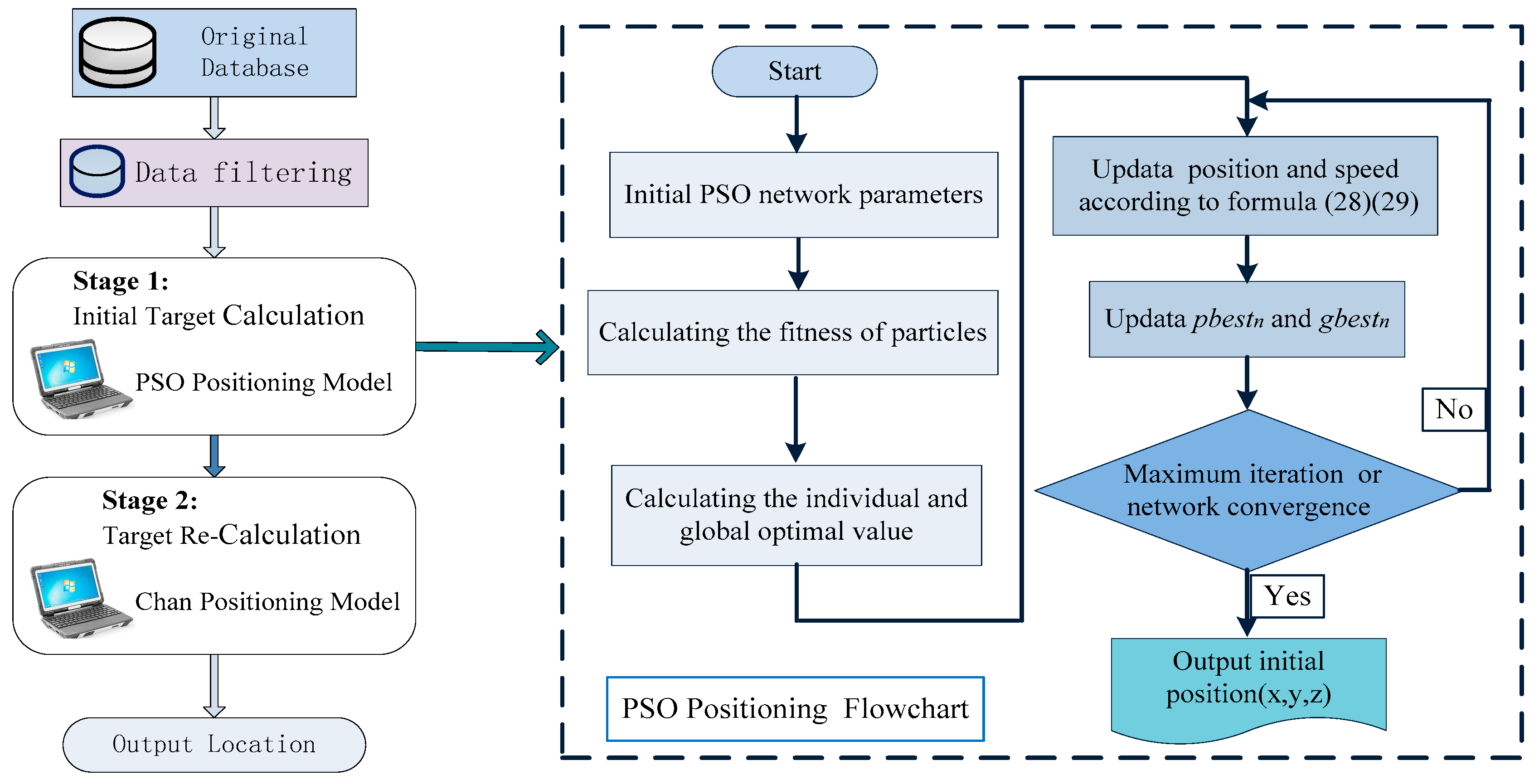
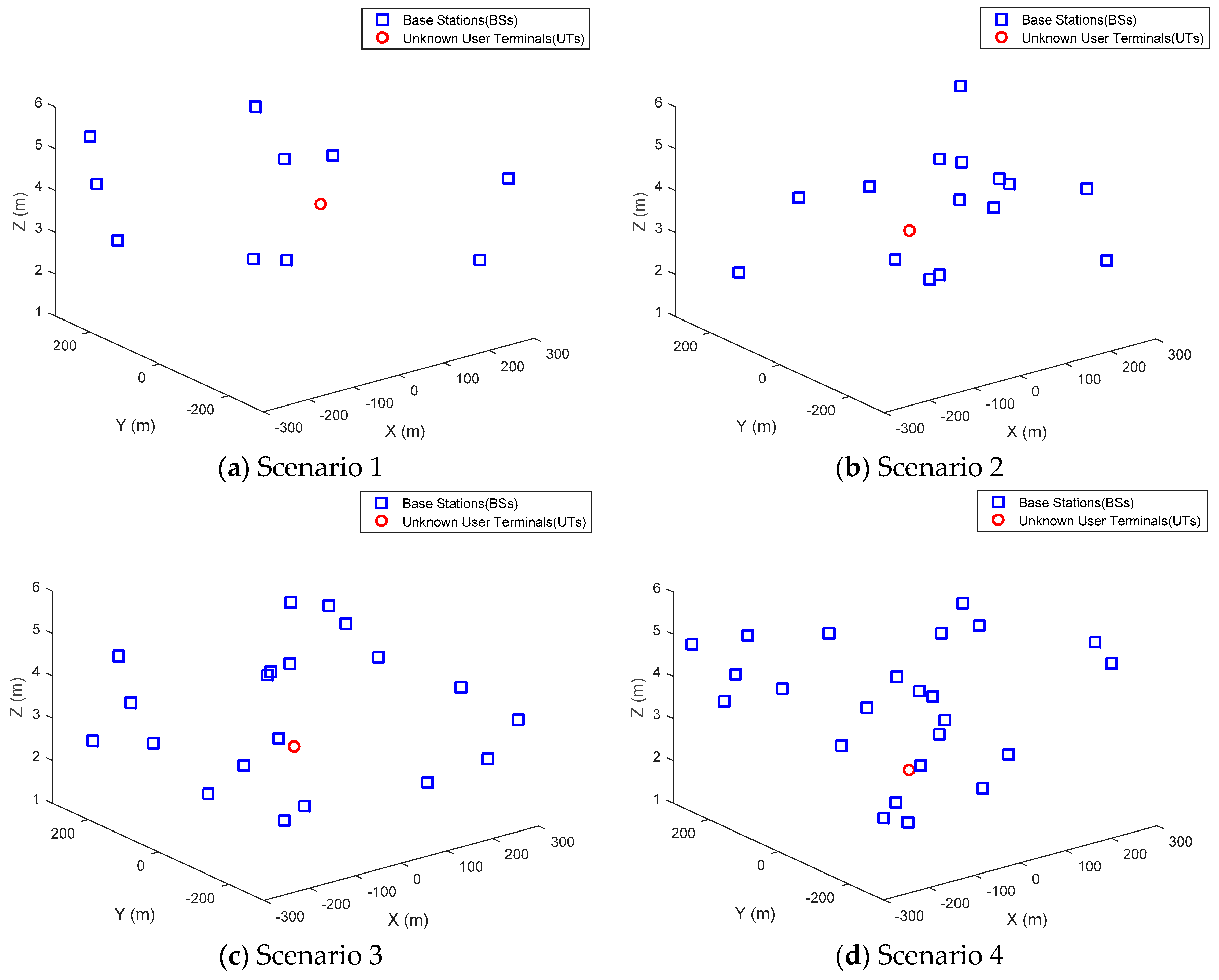
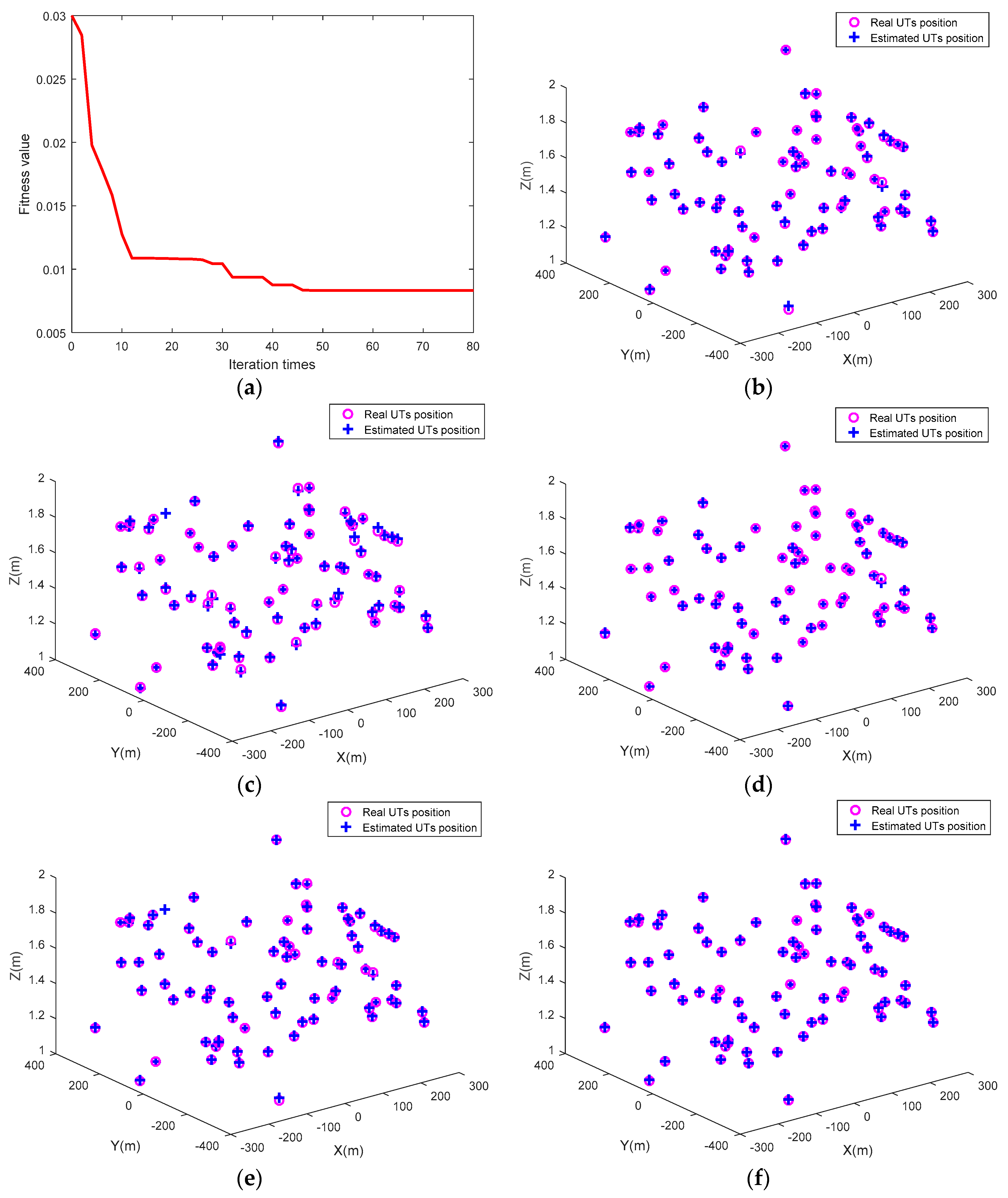
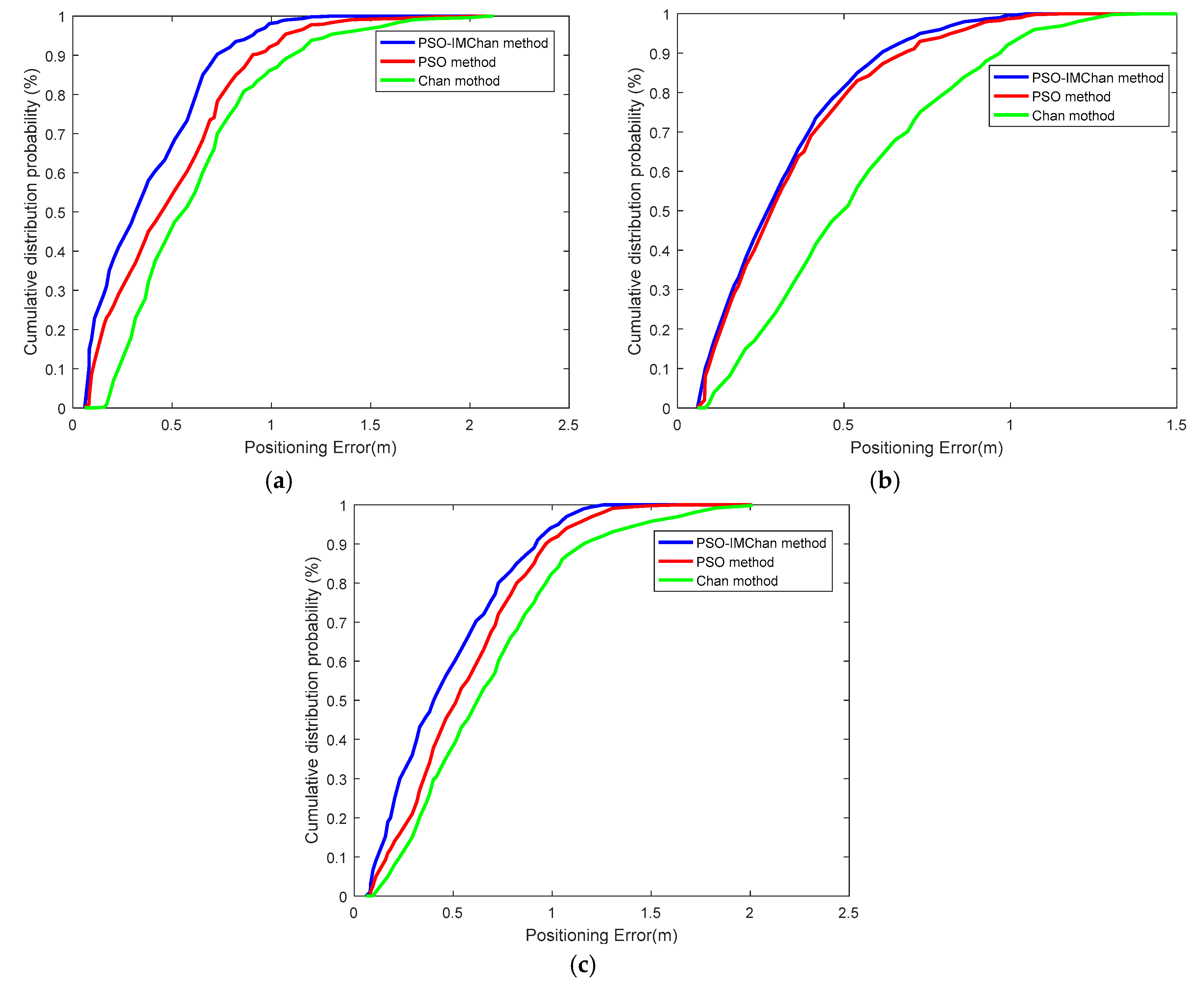

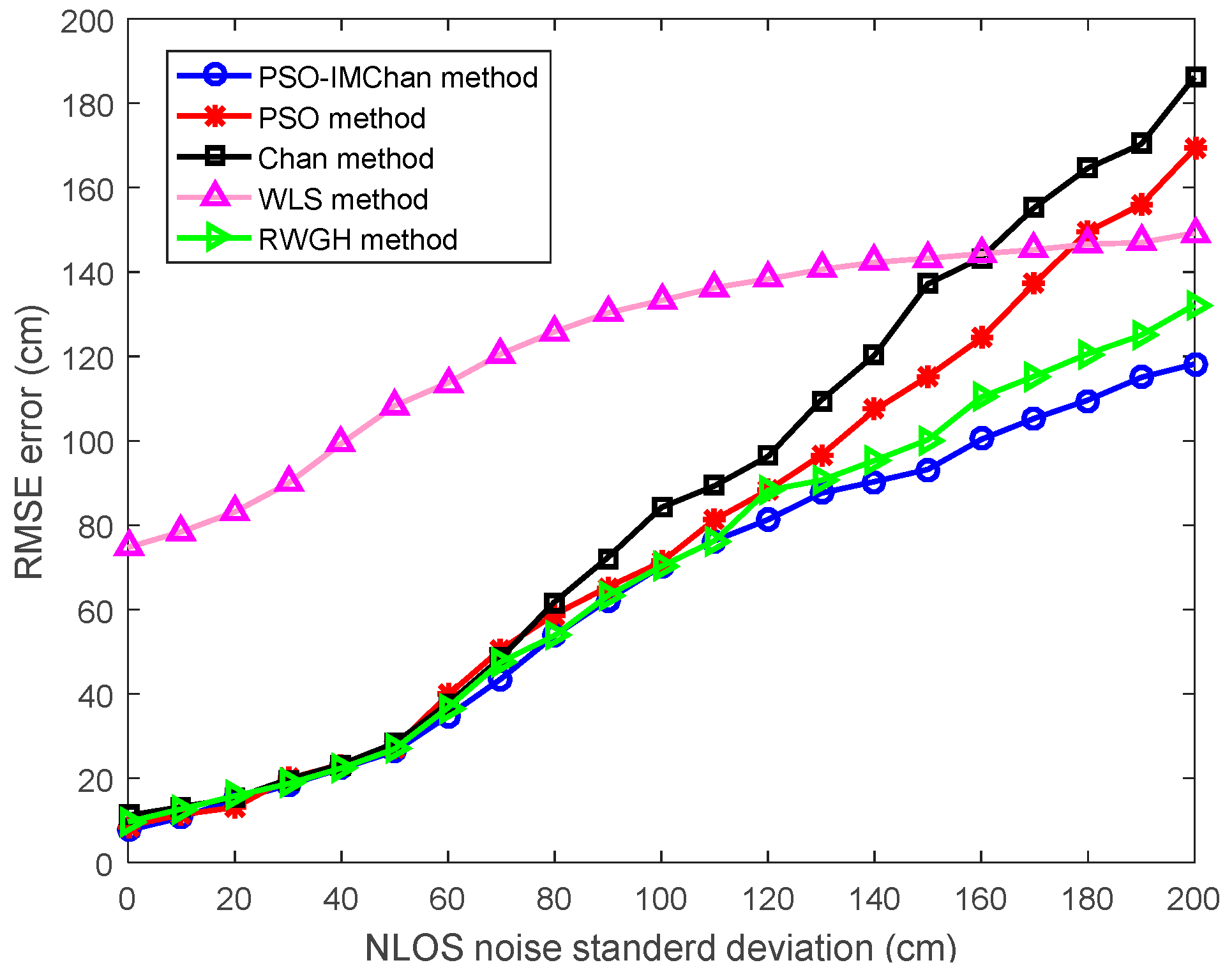
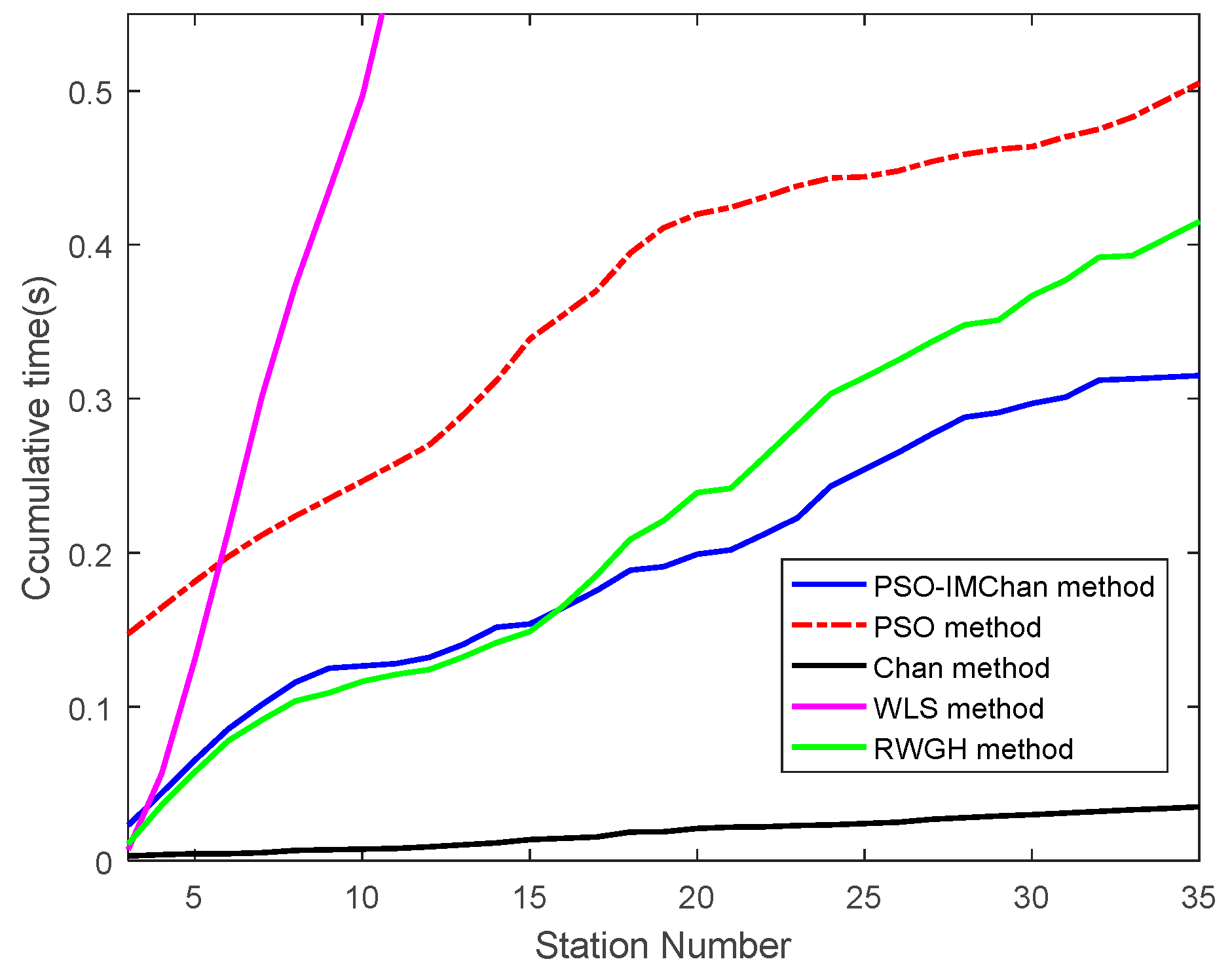
| Pars. | Inertia Weight | Iteration Number | Population Size | Learning Factor | Range of Velocity and Position |
|---|---|---|---|---|---|
| 80 | 50 | [−1, 1] |
| Positioning Error | PSO | Chan | PSO-IMChan | WLS | RWGH | |
|---|---|---|---|---|---|---|
| Scenario 1 | Min | 0.1686 | 0.5087 | 0.1684 | 0.1133 | 0.2928 |
| Max | 2.0511 | 2.2832 | 1.6282 | 1.5454 | 1.7821 | |
| Mean | 1.1843 | 1.4827 | 0.9053 | 0.8911 | 1.1104 | |
| Std. | 0.9249 | 1.1015 | 0.7185 | 0.7102 | 0.9033 | |
| Scenario 2 | Min | 0.1664 | 0.3424 | 0.0891 | 0.0779 | 0.2999 |
| Max | 1.9279 | 1.9867 | 1.4129 | 1.5444 | 1.5118 | |
| Mean | 0.9114 | 1.3428 | 0.7334 | 0.8812 | 0.8823 | |
| Std. | 0.7744 | 0.9351 | 0.5579 | 0.5688 | 0.5518 | |
| Scenario 3 | Min | 0.0805 | 0.2057 | 0.0559 | 0.0483 | 0.1922 |
| Max | 1.8464 | 2.0888 | 1.2594 | 1.5512 | 1.2046 | |
| Mean | 0.9025 | 1.1146 | 0.6473 | 0.7684 | 0.8708 | |
| Std. | 0.7199 | 0.8593 | 0.4372 | 0.5677 | 0.4021 | |
| Scenario 4 | Min | 0.0685 | 0.1143 | 0.0547 | 0.0588 | 0.1818 |
| Max | 1.6886 | 1.8817 | 1.0114 | 1.6444 | 1.2233 | |
| Mean | 0.8692 | 1.0119 | 0.5087 | 0.6659 | 0.5991 | |
| Std. | 0.6328 | 0.7392 | 0.4130 | 0.5633 | 0.4144 | |
© 2018 by the authors. Licensee MDPI, Basel, Switzerland. This article is an open access article distributed under the terms and conditions of the Creative Commons Attribution (CC BY) license (http://creativecommons.org/licenses/by/4.0/).
Share and Cite
Chen, S.; Shi, Z.; Wu, F.; Wang, C.; Liu, J.; Chen, J. Improved 3-D Indoor Positioning Based on Particle Swarm Optimization and the Chan Method. Information 2018, 9, 208. https://doi.org/10.3390/info9090208
Chen S, Shi Z, Wu F, Wang C, Liu J, Chen J. Improved 3-D Indoor Positioning Based on Particle Swarm Optimization and the Chan Method. Information. 2018; 9(9):208. https://doi.org/10.3390/info9090208
Chicago/Turabian StyleChen, Shanshan, Zhicai Shi, Fei Wu, Changzhi Wang, Jin Liu, and Jiwei Chen. 2018. "Improved 3-D Indoor Positioning Based on Particle Swarm Optimization and the Chan Method" Information 9, no. 9: 208. https://doi.org/10.3390/info9090208




